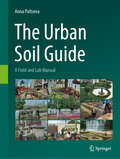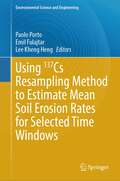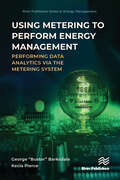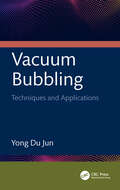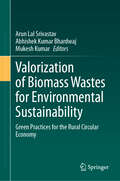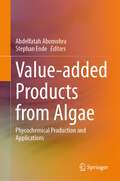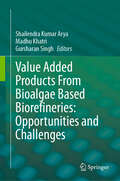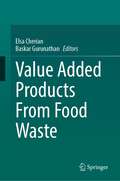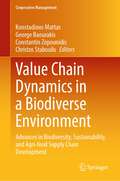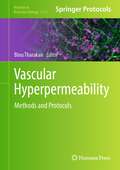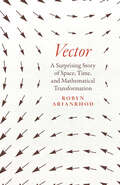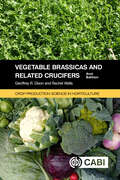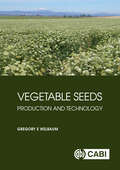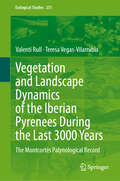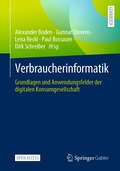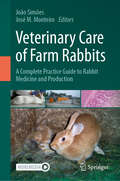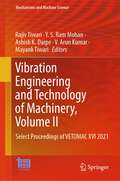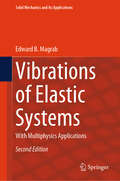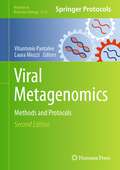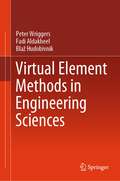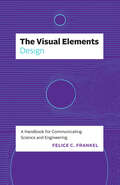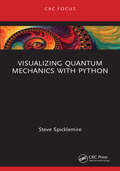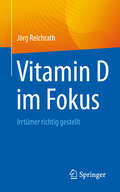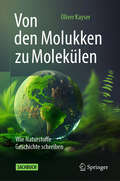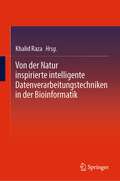- Table View
- List View
The Urban Soil Guide: A Field and Lab Manual
by Anna PaltsevaDelve into the fascinating world of soil science with "The Urban Soil Guide," a comprehensive manual designed for everyone from science beginners to seasoned horticulturists. Whether you're an introductory science student, a passionate gardener, a landscape designer, or a professional horticulturist, this guide is tailored for you. Packed with a variety of hands-on activities, this guide makes learning soil science both accessible and enjoyable. From simple experiments that can be performed in your kitchen to more advanced techniques, it offers a practical approach to understanding soil. Written by a soil scientist, this guide bridges the gap between professional knowledge and amateur enthusiasm. The Urban Soil Guide is versatile enough to serve as a textbook in botanical gardens and university classes, while also being an invaluable resource for amateurs. Choose activities that match your interest and level of expertise. Embark on your journey to becoming a soil expert with The Urban Soil Guide – your hands-on companion in the world of soil science.
Using 137Cs Resampling Method to Estimate Mean Soil Erosion Rates for Selected Time Windows (Environmental Science and Engineering)
by Paolo Porto Emil Fulajtar Lee Kheng HengThis book provides guidelines for using a new approach of resampling the Cs-137 radionuclide tracer which is used to estimate soil erosion rates. The Cs-137 resampling approach will improve significantly the use of the Cs-137 method for assessment of soil erosion, because resampling the radionuclide repeatedly (at least two times, but more sampling campaigns are possible) allows to avoid several methodological difficulties associated with Cs-137 method, namely the problems with small-scale spatial heterogeneity, the question of representativeness of reference site, reference samples, and inappropriate time extent of evaluated period. All these methodological problems are very important for reliability and accuracy of erosion rates estimated by Cs-137 method. If using single sampling approach, the small-scale spatial heterogeneity can be overcome by high number of sampling points, but this is time and labour demanding solution increasing the expenses of the erosion research. The representativeness of reference site is evaluated usually on the basis of expert judgement and knowledge of land use history of studied area, but this approach is often uncertain because the expert judgement can be subjective and the data on land use history is often not sufficient. Further, in many areas an appropriate reference site is not available, what limits the territorial extent of using Cs-137 method. The resampling approach offers its second sampling to be done in a proximate vicinity of the same points sampled during the first sampling campaign. A great advantage is the possibility to decide how long time windows should be investigated. Choosing the time schedule of first and second sampling allows to shorten the time window and adjust it to the study objectives. This is a great improvement of the Cs-137 method, because the time period since the Cs-137 fallout is still growing and thus if using the single sampling approach the results refer to still longer and longer time window(since the Cs-137 fallout until the sampling time), and this period (recently ca 60 years assuming the maximum Cs-137 fallout in 1963) is too long to represent stable land use, because land uses are changing over the time and having the same land use over six decades is rather rare. The improvement of Cs-137 method achieved by resampling approach is significantly contributing to understanding the erosion dynamics and estimating its rates under changing environmental conditions (such as land uses, weather), and it will bring a significant benefit to soil conservation programmes, because Cs-137 method is indispensable for assessing the medium and long term soil erosion rates, and this information is among the basic inputs needed for planning and designing soil conservation measures.
Using Metering to Perform Energy Management: Performing Data Analytics via the Metering System (River Publishers Series in Energy Management)
by George “Buster” Barksdale Kecia PierceThis book covers many helpful analysis tools and processes to assist energy managers (EMs) administer their energy program through their meter management system (MMS). These tools and the corresponding techniques offer opportunities for the EM to optimize their time. If fully utilized, the MMS will allow an EM to reduce field time significantly, as they can perform most of the energy management pre-analysis, benchmarking, data analysis and, in many cases, complete the task of performing a virtual audit remotely from their office.The book covers many instructional areas that are, for the most part, only offered by consulting groups and software vendors as services. Those two groups offer their services for fees and therefore do not publish their ideas or best practices for commercial use. Software vendors provide software analytics whose functional aspects are addressed by our descriptions of the essential tasks in each chapter. This book allows EMs to expand their knowledge of software capabilities by viewing other best practices. Consulting groups offer services in a few areas: basic benchmarking and monitoring-based commissioning (MBCx). These services are considered essential to energy management but are generally implemented as on-site services, which, due to their nature, are much more expensive than a monitoring commissioning (MCx) solution. Monitoring commissioning, in contrast to MBCx, is purely done at the monitoring level and allows you to manage the critical energy measures that comprise the majority of the savings, but without getting into the field testing.Benchmarking is covered much deeper in the book as we show how to benchmark each system within a building. The benchmarking sections show how to automatically analyze each system’s usage into a separate benchmark for baseload, lighting, AC, and fan/pump systems. These systems produce benchmarks so EMs can compare by site, category type, climate zone, etc. We also introduce benchmarks that enable the EM to utilize tools to determine the performance of each system and which are their most significant energy users. These analytics functions are covered to produce results that identify potential energy savings for each energy system.
Vacuum Bubbling: Techniques and Applications
by Yong Du JunVacuum Bubbling introduces the background and applications for generating bubbles under a vacuum condition, accomplished through depressurization without the need to heat water. It presents the advantage of utilizing vapor bubble in deaeration applications because the diffusion for degassing happens between the water body and micro vapor bubbles without the need of membrane or packing.Instead of relying on massive heating, vacuum bubbling focuses on depressurization down to the level of saturated vapor pressure or below to secure vapor bubbles with virtually zero dissolved non-condensable gases, including oxygen. The book considers prospective applications, such as extracting high-oxygen-content air from water for underwater breathing, pretreatment of aircraft fuel before being pumped into a fuel tank system, and probable desalination applications through massive bubbling combined with low-grade renewable energy.The book is intended for researchers in thermal fluids, heat and mass transfer, process engineering, and water treatment fields and industry professionals working in power generation, plant and process engineering, transportation, and energy.
Valorization of Biomass Wastes for Environmental Sustainability: Green Practices for the Rural Circular Economy
by Mukesh Kumar Arun Lal Srivastav Abhishek Kumar BhardwajThis volume discusses the reduction, recycling, and reuse of industrial and agricultural biomass wastes to develop value-added products using environmentally sustainable practices and technologies. Through these waste valorization approaches, biomass waste materials can be converted into useful bio-chemical products, sustainable construction materials, polymers, bio-energy, and bio-fuel as sustainable alternatives to products and materials with negative environmental and health consequences. The chapters highlight the development and implementation of eco-friendly solutions to biomass waste production with the aim of reducing natural resource deterioration, bolstering rural and small-scale business systems in communities impacted by pollution and climate change, and providing power from residual biomass to broadly reduce environmental impacts through improved waste management practices. The book is intended to be a useful resource for researchers, policymakers, NGOs, government agencies, and local community authorities working in waste management and environmental sustainability.
Value-added Products from Algae: Phycochemical Production and Applications
by Abdelfatah Abomohra Stephan EndeThis book provides a comprehensive overview of value-added products from algae, presenting the fundamentals of algal cultivation, metabolism, harvest, and cellular pathways of phycochemicals biosynthesis. It offers sufficient details for both experts and non-experts to grasp the recent progress in this field. The book also discusses new phycochemicals and advancements in technology development, from separation to scale-up commercialization. Divided into 18 chapters, the book begins with an introduction to the value of algae as a renewable resource, followed by an authoritative overview of topics such as algae cultivation systems, harvesting techniques, phycochemical analysis, artificial intelligence in phytochemical recognition, and bioprocess engineering. Additional chapters cover various aspects of algal biotechnology, including biorefinery technology, biofuel-integrated routes, and the use of wastewater for algal growth. The book also explores high throughput screening methods for microalgae-based phycochemicals and examines the catalytic processes involved in algal bioprocessing. Cutting-edge topics such as omics approaches for algal applications, algal-based biopolymers, diatom nanostructured biosilica, and the potential of seaweeds in methane emission mitigation, are also explored. In this book, readers will discover the recent technological applications of algae in aquaculture and will find a case study on the functional food potential of Spirulina. Recognizing the importance of legislation and biosecurity in the field, the last chapter of the book addresses the regulatory frameworks and biosecurity measures necessary for the safe and sustainable development of algal biotechnology. Given its breadth, the book is a valuable resource for scholars, researchers and professionals interested in algal biotechnology, sustainability, biomass conversion, and new algal products from any perspective.
Value Added Products From Bioalgae Based Biorefineries: Opportunities and Challenges
by Shailendra Kumar Arya Madhu Khatri Gursharan SinghThis book covers wide aspects of algal technology and algae-based biorefinery aspects. Algae are the most prevalent, primitive, and abundant microbes on Earth, however, the commercialization of algal-based value-added products is still low due to the negligible dissemination of knowledge flow among the stakeholders and researchers.This book provides up-to-date information on the cultivation of microalgae, their harvesting, downstream processing, and diverse applications. It further discusses the macromolecules existing in microalgae, such as proteins, carbohydrates, and lipids, poly-unsaturated fatty acids, peptides, exo-polysaccharides, flavonoids and antioxidants. This book also highlights the advantages and some real-time challenges before the establishment of sustainable algal-based biorefineries. Further, it includes clear flow charts and figures in each chapter to aid in interpretation of every technical concept. This book motivates readers, entrepreneurs, and young farmers to exploit easily growing microalgae through cottage to large-scale biorefineries and start their own businesses for the production of value-added products.
Value Added Products From Food Waste
by Elsa Cherian Baskar GurunathanThe rapid increase in industrial processes for the preparation and processing of various food products have resulted in the creation of large quantities of waste. These food wastes contain large amounts of nutrients which can be further converted into useful products, making byproduct technology increasingly important.Byproducts produced from various agro-based industries like cereals, fruits, vegetable processing, fish, meat and poultry can be converted into beneficial products. For instance, cereal and legume processing produces large quantities of wastes which can result in environmental problems affecting air, soil and water quality. These wastes can be efficiently utilized and converted into value added products such as bioethanol, butanol, biohydrogen, biogas, biocoal, industrially treasured enzymes, biofertilizer, proteins and organic acids. Value Added Products From Food Waste covers waste management techniques utilized for managing raw materials in the food industry in an efficient way, recovering and reusing waste or neutralizing unwanted components. Chapters focus on the latest technologies and efficient management systems in all areas of food processing that make this process economical and minimize the hazards caused by the deposition of waste. From the dairy industry to cereals to fruits and vegetables to fish, each aspect of the food industry is examined with an eye for how to utilize food waste, transforming these wastes into value added products.
Value Chain Dynamics in a Biodiverse Environment: Advances in Biodiversity, Sustainability, and Agri-food Supply Chain Development (Cooperative Management)
by Konstadinos Mattas George Baourakis Constantin Zopounidis Christos StaboulisThis book offers comprehensive insights into the latest developments in biodiversity, sustainability, and agri-food supply chains, fostering an informed approach to policymaking decisions in the agriculture and agri-food industry within the global economy. By addressing key societal and environmental challenges, such as desertification, floods, epidemics, rising trade costs, and food insecurity, it presents pioneering research initiatives to guide informed decision-making. Addressing the inadequate sustainability performance of agri-food supply chains due to complex stakeholder interactions and conflicting objectives, the book includes chapters on mapping the Cretan vegetable supply chain, trade initiatives in Latin America and the Caribbean, cooperative member commitment, sustainable food consumption patterns, water resource management in Africa, value-chain development, a financial analysis of the brewery industry, and the value chain of carob-flour production. The book aims to promote biodiversity conservation by establishing sustainable supply chains in the global agri-food sector. Given its scope, the book is intended for a diverse audience, including academics, businesses, policymakers, and stakeholders.
Vascular Hyperpermeability: Methods and Protocols (Methods in Molecular Biology #2711)
by Binu TharakanThis volume focuses on the latest research methods and techniques used by researchers to study vascular permeability/hyperpermeability in a science laboratory setting. The chapters in this book cover topics such as determination of solute permeability of microvascular endothelial cell monolayers in vitro; evaluation of barrier integrity used in a two-layered microfluidic device mimicking the blood-brain barrier; isolation and culture of human umbilical vein endothelial cells; measurement of blood-brain barrier hyperpermeability using Evans Blue extravasation assay; lymphatic vascular permeability determined from direct measurements of solute flux; intravital imaging of leukocyte-endothelial interaction by intravital multiphoton microscopy; and evaluation of tight junction integrity in brain endothelial cells using confocal microscopy. Written in the highly successful Methods in Molecular Biology series format, chapters include introductions to their respective topics, lists of the necessary materials and reagents, step-by-step, readily reproducible laboratory protocols, and tips on troubleshooting and avoiding known pitfalls.Thorough and cutting-edge, Vascular Hyperpermeability: Methods and Protocols is a valuable resource that will aid novice researchers with creating new and affordable research projects, and for expert researchers to initiate new strategies and collaborations in their ongoing programs.
Vector: A Surprising Story of Space, Time, and Mathematical Transformation
by Robyn ArianrhodA celebration of the seemingly simple idea that allowed us to imagine the world in new dimensions—sparking both controversy and discovery. The stars of this book, vectors and tensors, are unlikely celebrities. If you ever took a physics course, the word “vector” might remind you of the mathematics needed to determine forces on an amusement park ride, a turbine, or a projectile. You might also remember that a vector is a quantity that has magnitude and (this is the key) direction. In fact, vectors are examples of tensors, which can represent even more data. It sounds simple enough—and yet, as award-winning science writer Robyn Arianrhod shows in this riveting story, the idea of a single symbol expressing more than one thing at once was millennia in the making. And without that idea, we wouldn’t have such a deep understanding of our world. Vector and tensor calculus offers an elegant language for expressing the way things behave in space and time, and Arianrhod shows how this enabled physicists and mathematicians to think in a brand-new way. These include James Clerk Maxwell when he ushered in the wireless electromagnetic age; Einstein when he predicted the curving of space-time and the existence of gravitational waves; Paul Dirac, when he created quantum field theory; and Emmy Noether, when she connected mathematical symmetry and the conservation of energy. For it turned out that it’s not just physical quantities and dimensions that vectors and tensors can represent, but other dimensions and other kinds of information, too. This is why physicists and mathematicians can speak of four-dimensional space-time and other higher-dimensional “spaces,” and why you’re likely relying on vectors or tensors whenever you use digital applications such as search engines, GPS, or your mobile phone. In exploring the evolution of vectors and tensors—and introducing the fascinating people who gave them to us—Arianrhod takes readers on an extraordinary, five-thousand-year journey through the human imagination. She shows the genius required to reimagine the world—and how a clever mathematical construct can dramatically change discovery’s direction.
Vegetable Brassicas and Related Crucifers (Crop Production Science in Horticulture)
by Geoffrey Dixon Dr Rachel WellsThe Brassica genus contains diverse and economically important species and crops, for example, Brassica oleracea including cauliflower to kohlrabi, B.rapa including pak choi to mizuna, and aquatic crucifers such as watercress. These provide humankind with huge diversities of foods, promoting health and well-being. This substantially expanded second edition reflects the significant advances in knowledge of plant breeding and crop production which have occurred since publication of the original book in 2006. Embracing new Brassicaceae research and concepts of sustainable and automated crop production, topics include: Brassica evolution and transcontinental spread as the basis for crop breeding Gene-editing, rapid sequencing, genetic markers and linkage mapping to enable efficient plant breeding Seed development, F1 cultivars and rapid maturing crops for profitable cropping Environmental impacts on pests, pathogens, crop reliability and quality Soil health and fertility as agronomic principles Environmental sustainability, biocontrol and integrated pest management Vegetable brassicas as nutrient-rich foods for optimal health benefits An invaluable resource for all those involved in Brassica production, this is essential reading for researchers and students in horticulture and plant science, growers, producers, consultants and industry advisors.
Vegetable Seeds: Production and Technology
by Gregory E WelbaumMost food and fiber crops are produced from seed. This means that the world's population is dependent on annual seed production for its food supply. Vegetable seed production is much different and more challenging than production of grain crops. This book explains the biology and technology behind producing, maintaining, and enhancing the quality of vegetable seeds from breeding through to the marketed product. It begins with six chapters on a broad range of seed-related topics: the importance of seeds, reproductive biology of plants, genetic improvement strategies, quality assurance of seed production, post-harvest seed enhancement, and organic production. The remaining chapters cover seed production in eleven important vegetable families. Each chapter provides a description of the botany, types and cultivars, genetic improvement, pollination, soil fertility management, pest management, crop production, harvesting, post-harvest handling, and seed yields. The aim of this book is to educate how to produce high-quality vegetable seeds. Incorporating both current methodologies and recent research results, it is suitable for students, researchers, and professionals in the seed industry.
Vegetation and Landscape Dynamics of the Iberian Pyrenees During the Last 3000 Years: The Montcortès Palynological Record (Ecological Studies #251)
by Valentí Rull Teresa Vegas-VilarrúbiaThe high-resolution palynological study of the varved sediments of Lake Montcortès has provided a unique record of the regional vegetation shifts over the last 3000 years and of the natural and anthropogenic drivers of ecological change, unparalleled in the Mediterranean. This book shows in detail how the terrestrial ecosystems of Montcortès have responded to climatic events such as the Medieval Climate Anomaly or the Little Ice Age, as well as to varying intensities of anthropogenic pressure from the Bronze Age to the present. The knowledge gained from this palaeoecological study is useful not only for understanding how the modern landscapes of the Pyrenees were shaped, but also for conserving biodiversity and ecosystems in the face of future environmental changes related to ongoing global change. The book is aimed at researchers, university teachers and advanced graduate students in a wide range of disciplines including ecology, palaeoecology, environmental science, biodiversity, geography, sedimentology, archaeology, anthropology, and biodiversity conservation.
Verbraucherinformatik: Grundlagen und Anwendungsfelder der digitalen Konsumgesellschaft
by Alexander Boden Gunnar Stevens Lena Recki Paul Bossauer Dirk SchreiberIn einer Zeit, in der digitale Technologien nahezu jeden Aspekt unseres Lebens durchdringen, ist es unerlässlich, die tieferen Zusammenhänge des digitalen Konsums zu verstehen. Erstmalig bietet dieses open access-Lehrbuch einen Wegweiser durch die vielfältigen Facetten der Digitalisierung des Konsums. Dabei verbindet es die Disziplinen der angewandten Informatik und Verbraucherwissenschaften. Die Leserinnen und Leser erhalten Einblick in die digitale Konsumlandschaft, ausgehend von der historischen Entwicklung des (digitalen) Konsums. Dazu vermittelt das Lehrbuch zentrale Grundbegriffe und Themen der Verbraucherinformatik und stellt verschiedene Konsumtheorien aus den Disziplinen Wirtschaftswissenschaften, Psychologie und Sozialwissenschaften vor. Praxisnahe Beispiele aus der Digitalisierung bieten Einsichten in unterschiedliche Perspektiven, während vertiefende Textboxen und Selbstreflexionsfragen das Verständnis fördern. Inhaltlich decken die Autorinnen und Autoren Themen von Datenschutz bis zur Sharing Economy ab und geben insbesondere auch praktische Ansätze für Themen wie Verbraucherschutz und Nachhaltigkeit mit auf den Weg. Die Anwendungs- und Querschnittsthemen der Verbraucherinformatik reichen von der Digitalisierung der Haushalte und Märkte über Fragen des digitalen Verbraucherschutzes bis hin zu zentralen gesellschaftlichen Fragestellungen rund um die Themen Fairness, Verantwortung und Nachhaltigkeit bei der Gestaltung von digitalen Technologien. Das Buch bietet einen umfassenden Überblick, der sowohl für Studierende der Wirtschafts- und Sozialwissenschaften als auch der angewandten Informatik von bedeutendem Wert ist.
Veterinary Care of Farm Rabbits: A Complete Practice Guide to Rabbit Medicine and Production
by João Simões José M. MonteiroThis holistic guide brings rabbit production science and medicine together. It considers the full spectrum of commercial rabbit husbandry, including intensive, semi-intensive, and organic systems for meat, fur and leather. Drawn from an international authorship, the book addresses practical and fundamental topics. In comprehensive sections, readers will find easy-to-read chapters on:• rabbit breeds, anatomy essentials and lagomorph physiology• rabbit production with details on animal facilities and farm design, international trading, rabbit meat processing and biosafety, including a vivid appendix on meat inspection• rabbit herd and health management, considering latest findings in welfare and behavior, preventive medicine, antimicrobial resistance and demedication to necropsy and specimen collection• significant rabbit diseases, covering encephalitozoonosis cuniculi, rabbit enteropathies, and many more• complete veterinary treatment, supplemented by reference ranges and interpretation of hematological and biochemical valuesBesides an increasing keeping of pet rabbits, the animals are gaining interest for sustainable food production, leading to a rise in farming in various parts of the world. In this context, the present guide provides valuable contributions for consulting veterinarians and students, industry professionals, breeders and technicians, as well as for experts from the small and companion animal sector.The relevance of rabbit farming from the viewpoints of greenhouse gas reduction and sustainable use of ecological resources (use of local feed) also creates useful links for readers interested in the sustainable development goals SDG 2 (Zero Hunger) and SDG 12 (Responsible Consumption and Production).
Vibration Engineering and Technology of Machinery, Volume II: Select Proceedings of VETOMAC XVI 2021 (Mechanisms and Machine Science #153)
by Rajiv Tiwari Y. S. Ram Mohan Ashish K. Darpe V. Arun Kumar Mayank TiwariThis book presents the proceedings of the XVI International Conference on Vibration Engineering and Technology of Machinery (VETOMAC 2021). It gathers the latest advances, innovations, and applications in the field of vibration and technology of machinery. Topics include concepts and methods in dynamics, dynamics of mechanical and structural systems, dynamics and control, condition monitoring, machinery and structural dynamics, rotor dynamics, experimental techniques, finite element model updating, industrial case studies, vibration control and energy harvesting, and MEMS. The contributions, which were selected through a rigorous international peer-review process, share exciting ideas that will spur novel research directions and foster new multidisciplinary collaborations. The book is useful for the researchers, engineers and professionals working in the area of vibration engineering and technology of machinery.
Vibrations of Elastic Systems: With Multiphysics Applications (Solid Mechanics and Its Applications #184)
by Edward B. MagrabThis book presents new topics such as Inerters in spring-mass models and attached to beams; fluid loading on beams, plates, and shells; bio-inspired vibration isolation and absorption; coupled bending and torsion of beams; beams with functionally graded materials; as well as a new chapter on the Mindlin/Timoshenko plate theory: rectangular and circular. New applications and enhancements to the previous edition include moving mass on beams; thin beams with attached pendulum; transient response of beams with in-span attachments; and shells to model blood flow in arteries.
Viral Metagenomics: Methods and Protocols (Methods in Molecular Biology #2732)
by Vitantonio Pantaleo Laura MiozziThis second edition volume expands on the previous edition with discussions about the latest viral metagenomics aspects covering a range of different specimens such as soil, freshwater, wastewater, fecal samples, blood plasma, clinical tissues, fungi, and herbarium samples. Chapters also look at different viral groups including archaeal viruses, eukaryotic viruses, phages, mycoviruses, and circular DNA viruses. Techniques required for studying the three viral metagenomic steps of samples processing, library construction, and analysis of data are also discussed. Written in the highly successful Methods in Molecular Biology series format, chapters include introductions to their respective topics, lists of the necessary materials and reagents, step-by-step, readily reproducible laboratory protocols, and tips on troubleshooting and avoiding known pitfalls.Authoritative and cutting-edge, Vital Metagenomics: Methods and Protocols, Second Edition is a valuable resource for researchers who are interested in learning more about this important and developing field.
Virtual Element Methods in Engineering Sciences
by Peter Wriggers Fadi Aldakheel Blaž HudobivnikThis book provides a comprehensive treatment of the virtual element method (VEM) for engineering applications, focusing on its application in solid mechanics. Starting with a continuum mechanics background, the book establishes the necessary foundation for understanding the subsequent chapters. It then delves into the VEM's Ansatz functions and projection techniques, both for solids and the Poisson equation, which are fundamental to the method. The book explores the virtual element formulation for elasticity problems, offering insights into its advantages and capabilities. Moving beyond elasticity, the VEM is extended to problems in dynamics, enabling the analysis of dynamic systems with accuracy and efficiency. The book also covers the virtual element formulation for finite plasticity, providing a framework for simulating the behavior of materials undergoing plastic deformation. Furthermore, the VEM is applied to thermo-mechanical problems, where it allows for the investigation of coupled thermal and mechanical effects. The book dedicates a significant portion to the virtual elements for fracture processes, presenting techniques to model and analyze fractures in engineering structures. It also addresses contact problems, showcasing the VEM's effectiveness in dealing with contact phenomena. The virtual element method's versatility is further demonstrated through its application in homogenization, offering a means to understand the effective behavior of composite materials and heterogeneous structures. Finally, the book concludes with the virtual elements for beams and plates, exploring their application in these specific structural elements. Throughout the book, the authors emphasize the advantages of the virtual element method over traditional finite element discretization schemes, highlighting its accuracy, flexibility, and computational efficiency in various engineering contexts.
The Visual Elements—Design: A Handbook for Communicating Science and Engineering (The Visual Elements)
by Felice C. FrankelWith insights and examples from designers at publications from Nature to the New York Times, an essential guide to creating figures and presentations. In this short handbook, award-winning science communicator Felice C. Frankel offers a quick guide for scientists and engineers who want to share—and better understand—their research by designing compelling graphics for journal submissions, grant applications, presentations, and posters. Like all the books in the Visual Elements series, this handbook is also a training tool for researchers. Distilling her celebrated books and courses to the essentials, Frankel shows scientists and engineers, from students to primary investigators, the importance of thinking visually. This crucial volume in the Visual Elements series offers a wealth of engaging design examples. Case studies and advice from designers at prestigious publications and researchers’ own before-and-after examples show how even the smallest changes—to color, type, composition, and layering—can greatly improve communication. Ideal for researchers who want a foothold for presenting and preparing their work for everything from conferences to publications, the book explains the steps for creating a concise and communicative graphic to highlight the most important aspects of research—and to clarify researchers’ own thinking. The resulting book is an essential element of any scientist’s, engineer’s, or designer’s library.
Visualizing Quantum Mechanics with Python
by Steve SpicklemireQuantum Mechanics can be an abstract and complex subject. Students often complain of confusion, struggle, and frustration as they try to master the topic. The goal of this book is to reduce the complexity and clarify the abstractions with concrete visual examples driven by simple python programs. It is assumed that the reader is concurrently taking a course in quantum mechanics, or self-studying quantum mechanics, but is looking for supplementary material to help with understanding and visualizing how quantum mechanics works.The focus of this book is writing python programs to visualize the underlying behavior of the mathematical theory. The background needed to understand quantum mechanics is differential equations, linear algebra and modern physics. We need a strong foundation in differential equations and linear algebra because the behavior of quantum systems is governed by equations that are written in terms of these concepts. Modern physics includes concepts such as special relativity and quantum phenomena like the photoelectric effect and energy quantization that the theory of quantum mechanics seeks to explain. This book is also not an introduction to the python programming language, or to numpy, or even to VPython. However its programming examples start simply and grow more complex as the chapters progress, so deep expertise in any of these is not a pre-requisite.Key features:· Provides an accessible and practical guide to the abstractions in quantum mechanics with concrete visual examples driven by simple python programs.· Contains few derivations, equations, and proofs.· For complete beginners of python programming, appendix B serves as a very brief introduction to the main concepts needed to understand the code in this book.Dr. Stephen Spicklemire is Associate Professor of Physics at the University of Indianapolis, USA. He has been teaching physics at the University of Indianapolis for more than 30 years. From the implementation of "flipped" physics class to the modernization of scientific computing and laboratory instrumentation courses, he has brought the strengths of his background in physics, engineering and computer science into the classroom. Dr. Spicklemire also does IT and engineering consulting. He is an active participant in several national research initiatives relating to improving physics education. These range from improving materials to help students prepare for class, to supporting students success through standards based grading. He is an active developer of the VPython and WebVPython projects and a contributor to the Matter and Interactions textbook.
Vitamin D im Fokus: Irrtümer richtig gestellt
by Jörg ReichrathWelchen Einfluss hat Vitamin D auf die Entstehung von Krebserkrankungen, Herz-Kreislauferkrankungen, Stoffwechsel- und Autoimmunerkrankungen? Wie gelingt die Balance zwischen notwendiger Sonneneinstrahlung und Vermeidung des Hautkrebsrisikos? Antworten auf diese und viele weitere Fragen zu diesem wichtigen Vitamin sowie der Vitamin D Mangelerkrankung Rachitis liefert das vorliegende Werk. Es räumt dabei mit häufigen Irrtümern über Aufbau, Funktion und Wirkung von Vitamin D auf und liefert darüber hinaus zahlreiche, praxisrelevante Fakten für eine optimale Versorgung. Der Autor ist ausgewiesener Experte auf dem Gebiet und seit über drei Jahrzehnten in der Forschung zu Vitamin D tätig. Das Buch wendet sich an Ärztinnen und Ärzte, die ihre Patientinnen und Patienten auf Basis neuester wissenschaftlicher Erkenntnisse rund um das Thema Vitamin D bestmöglich versorgen und informieren möchten.
Von den Molukken zu Molekülen: Wie Naturstoffe Geschichte schreiben
by Oliver KayserNaturstoffe sind ein Wunderwerk der Evolution. Pflanzen sind chemische Fabriken und haben mit ihren außergewöhnlichen Eigenschaften eine riesige Anzahl sehr vielfältiger interessanter Naturstoffe hervorgebracht, die wir Menschen seit Jahrhunderten zur Linderung und Heilung von Krankheiten nutzen. Spätestens seit der Entdeckung des Penicillins sind Naturstoffe zu einer wichtigen Quelle für Medikamente geworden, aber wir kennen nur sehr wenige der vermutlich vielen Millionen, die auf ihre Entdeckung warten. Zu den Naturstoffen gehören wichtige Antibiotika, Immunsuppressiva, Antikrebsmittel, Hormone und auch antivirale Wirkstoffe. Aber haben Naturstoffe im Zeitalter der Bio- und Gentechnologie überhaupt noch eine Bedeutung? Ja, mehr denn je, denn Medizinalchemiker holen sich kreative Anregungen für ihre Synthesen aus der Natur, um den nächsten Blockbuster in der Medizin zu entwickeln. Oliver Kayser erzählt in diesem Buch die Geschichte der Naturstoffe und Medizinpflanzen auf höchst informative und amüsante Weise aus einem neuen Blickwinkel. Er geht der Frage nach, wie Naturstoffe aus der Naturheilkunde die pharmazeutische Industrie ins Leben riefen, wie sie als Arznei- und Heilmittel unsere Gesellschaft prägten, wie sie Kriege ermöglichten und den Weg zu Nobelpreisen ebneten. Der Autor zeichnet ein faszinierendes Panorama der Naturstoffchemie in Pflanzen, Mikroorganismen und Tieren. Beginnend mit den ersten Isolierungen zu Anfang der industriellen Revolution führt er uns mit den Ideen und der Begeisterung vieler Wissenschaftlerinnen und Wissenschaftler in die Moderne der Wirkstofftests, der Computerchemie und der höchst erfolgreichen Zufallsentdeckungen von Wirkstoffen. Die Naturstoffforschung im Labor hat einen enormen Einfluss auf unser heutiges Leben. Der Autor lässt sich über die Schulter schauen, wie heute die Suche nach den neuen Medikamenten von morgen funktioniert. Das Buch ist das ultimative Buch aus der Feder eines Wissenschaftlers, der tief in der Forschung verwurzelt ist und dem Leser einen erhellenden und zugleich kurzweiligen Einblick gibt, wie Wissenschaftler ticken und wie mühsam Forschung sein kann.
Von der Natur inspirierte intelligente Datenverarbeitungstechniken in der Bioinformatik
by Khalid RazaDieses Buch umfasst und beschäftigt sich mit den jüngsten Fortschritten und modernsten Anwendungen von naturinspirierten Computertechniken (NIC) im Bereich der Bioinformatik und der Computerbiologie, die die medizinischen Wissenschaften bei verschiedenen klinischen Anwendungen unterstützen können. Dieser Sammelband befasst sich mit den grundlegenden Anwendungen, dem Umfang und den Zukunftsperspektiven von NIC-Techniken in der Bioinformatik, einschließlich der Erstellung von Genomprofilen, der Klassifizierung von Genexpressionsdaten, der DNA-Berechnung, der System- und Netzwerkbiologie, der Lösung von Komplikationen bei personalisierten Therapien, der antimikrobiellen Resistenz bei bakteriellen Krankheitserregern und der computergestützten Entwicklung von Arzneimitteln, deren Entdeckung und Therapie. Darüber hinaus wird die Rolle von NIC-Techniken bei verschiedenen Krankheiten und Störungen behandelt, einschließlich Krebserkennung und -diagnose, Brustkrebs, Erkennung von Lungenkrankheiten, Krankheits-Biomarkern und Identifizierung potenzieller Therapeutika.
